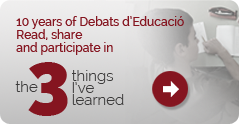- Català
- Español
- English
You are here
Cities as connected learning networks - The Pittsburgh Remake Learning model
About the speaker
Sunanna Chand
Learning Innovation Strategist with the Remake Learning Council.
Summary of ideas
In 2007, a group of teachers in Pittsburgh started to meet up to consider how to approach student learning in a changing world, in which technology played a major role. They confirmed that they were not connected with their students and that students were subject to lots of information.
The first informal network was enlarged to discover different points of view and to seek learning tools both inside and outside school. This led to the creation of Remake Learning. In 2017, the network is made up of 500 organizations, including museums, libraries, not-for-profit organizations, universities, companies, entrepreneurs, artists, politicians and technology experts, among others.
The aim is to make learning motivating, relevant and inclusive. It should have a major practical component and also involve families. In fact, every now and then Remake Learning holds open days so that families can participate in the learning activities.
What is this network like?
- It is built on the city's strong points. Pittsburgh is a city which has reinvented itself many times and in which STEM plays a key role.
- The network is broad in its reach. Organizations and individuals from different sectors have been invited to participate: education, commerce, politics, technology, culture, etc.
- Teachers have been given support to innovate.
- People have been searched for far and wide, irrespective of their location.
- The network is open and inclusive.
- It is the time to be bold and not fear change.
- Students are at the heart of the network.
How do you go from a group holding informal meetings to the Remake Learning ecosystem?
- By investing in infrastructure: creating a brand and platforms to become known and offering information, for example via social media and a web page. Remake Learning received financial aid to do this from a philanthropic organization.
- By identifying individuals and organizations you want to be involved and inviting them to take part.
- It does not require a huge budget. You need to mobilize existing resources and ensure actors converge.
- By holding open or public learning days.
How can we get teachers to sign up to the initiative?
- We start by involving the heads of schools, who already work in an innovative way.
- We offer support to teachers in the use of technology. Teachers have to feel comfortable using technology as a learning tool.
- By getting some schools to influence others by telling them about their experiences.
- By publishing reports on innovative and interdisciplinary learning experiences.
How can we create personalized learning strategies?
- By asking the students. By enquiring about their motivations and the solutions they apply to problems.
- By using technology to simplify the bureaucratic tasks of teachers so they have more time for each student. The teacher must establish a good relationship with the students and with their families.
Technology is very important in this model. But what mistakes can be made in the use of technology?
- Technology is not the solution to everything. It is a tool which motivates the students. The mistake is to provide the technology without guidance on how to use it. Technology does not replace the teacher. The teacher has to provide guidance on how to use it for a specific task.
How have we succeeded in getting families to appreciate the value of learning networks?
- By conducting activities for families so they can experience with the students what learning outside the classroom entails.
- By explaining that basic learning is still carried out, but in a different way, with more motivating activities. We need them to see that the school is not the only place one can learn.
- The next step is to make the families the ones who demand change in the school in order to obtain more motivating and relevant learning.
Does learning outside the classroom also require accreditation credentials?
- We operate with digital credits which accumulate. To do certain activities, it is necessary to have digital credits from previous activities. The aim is that these credits will also accredit training to access the world of employment.
Is it important to have a brand?
- Marketing and branding are very important, as is making it clear how to connect and interact with the network. We need to explain what the network does and who its members are. It is useful for improving interaction, and also in seeking funding.
- Remake Learning has a playbook which explains its work and the strategies that can be implemented to create a similar network.
How is the network evaluated?
- There are a series of statistics which back up the work of Remake Learning. A report has been drafted on the 10 years it has been in operation. For example, thousands of families participate in the open days; over 600 free and public activities have been organized.
With the collaboration:
Discover
other ideas
-

The spiral of inquiry: a tool for educational tran...
Judy Halbert and Linda Kaser
2017 -

Building a school for the digital natives generati...
Kirsti Lonka
2017 -

How to ensure that technological innovation improv...
Steven Hodas
2017







 The texts published on this website are, unless otherwise indicated, covered by the Creative Commons Spain Attribution - Non Commercial - No Derivs 3.0 licence. You may copy, distribute and transmit the work, provided you attribute it (authorship, journal name, publisher) in the manner specified by the author(s) or licensor(s). You may not use the material for commercial purposes. You may not transmit any derivative work from this material. The full text of the licence can be consulted here:
The texts published on this website are, unless otherwise indicated, covered by the Creative Commons Spain Attribution - Non Commercial - No Derivs 3.0 licence. You may copy, distribute and transmit the work, provided you attribute it (authorship, journal name, publisher) in the manner specified by the author(s) or licensor(s). You may not use the material for commercial purposes. You may not transmit any derivative work from this material. The full text of the licence can be consulted here: